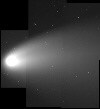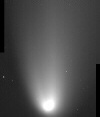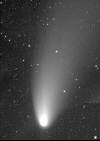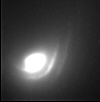

taken by Gianluca Masi, Ceccano (FR) Italy

Read me !

These sixtheen images show the evolution of the inner
region of the coma, around the nucleus. They have been taken on 3, 9, 11,
12, 20, 21, 26, 31 March; 4, 6, 8, 10, 17, 19, 24 April; 3 May 1997. It
is visible how the nucleus appearance has changed with the time. Reflector
15 cm f/5, CCD SBIG ST-7, elaboration: QMiPS32.

3 May 1997. This is a three frame mosaic, taken from
19.11 to 19.18 U.T. Each frame 1 min exposure. Reflector 15 cm f/5, CCD
SBIG ST-7. Log-scaled.

3 May 1997. This picture shows the inner region around
the nucleus, with dust waves. 19.07 U.T. 5 sec exposure. Reflector 15 cm
f/5, CCD SBIG ST-7; elaboration: QMiPS32.

3 May 1997. This picture shows the hidden features
of the region near the nucleus. 19.09 U.T. 10 sec exposure. Reflector 15
cm f/5, CCD SBIG ST-7; elaboration: QMiPS32 (Larson/Sekanina).

24 April 1997. This picture shows the inner coma.
18.54 U.T. 30 sec exposure. Reflector 15 cm f/5, CCD SBIG ST-7. Log-scaled.

24 April 1997. This picture shows the inner region
around the nucleus, with dust waves. 19.02 U.T. 1 sec exposure. Reflector
15 cm f/5, CCD SBIG ST-7; elaboration: QMiPS32.

24 April 1997. This picture shows the hidden features
of the region near the nucleus. 19.15 U.T. 8 sec exposure. Reflector 15
cm f/5, CCD SBIG ST-7; elaboration: QMiPS32 (Larson/Sekanina).

19 April 1997. This is a four frame mosaic, taken
from 19.31 to 19.42 U.T. Each frame 1 min exposure. Reflector 15 cm f/5,
CCD SBIG ST-7

19 April 1997. 18.26 U.T. 3 sec. exposure This picture
shows the inner region around the nucleus, with dust waves. Reflector 15
cm f/5, CCD SBIG ST-7, elaboration: QMiPS32.

As above, but displayed in the form of 3D plot. Look
at the shells.

17 April 1997. This is a four frame mosaic, taken
from 19.58 to 20.07 U.T. Each frame 1 min exposure. Some clouds in the
sky. Reflector 15 cm f/5, CCD SBIG ST-7

17 April 1997. 20.10 U.T. 3 sec. exposure This picture
shows the inner region around the nucleus, with dust waves. Reflector 15
cm f/5, CCD SBIG ST-7, elaboration: QMiPS32.

10 April 1997. This picture shows the hidden features
of the region near the nucleus. 19.09 U.T. 10 sec exposure. Reflector 15
cm f/5, CCD SBIG ST-7; elaboration: QMiPS32 (Larson/Sekanina).

These four images show the evolution of the inner
region of the coma, around the nucleus. They have been taken on 4, 6, 8,
10 April 1997. It is clearly visible the dust waves expansion and how the
luminosity of the shells changes with the time.Reflector 15 cm f/5, CCD
SBIG ST-7, elaboration: QMiPS32.

8 April 1997. This picture shows the inner coma.
18.52 U.T. 1 min. exposure. Reflector 15 cm f/5, CCD SBIG ST-7. Log-scaled.

8 April 1997. This picture shows the hidden features
of the region near the nucleus. 18.45 U.T. 15 sec exposure. Reflector 15
cm f/5, CCD SBIG ST-7; elaboration: QMiPS32 (Larson/Sekanina).

6 April 1997. 18.57 U.T. 1 min exposure. Lens 180
mm f/2.8, CCD SBIG ST-7, elaboration: QMiPS32. Note the open cluster M34
on the left.

6 April 1997. This is a five frame mosaic, taken
from 18.57 to 19.12 U.T. Each frame 1 min exposure. Lens 180 mm f/2.8,
CCD SBIG ST-7. Log-scaled.

4 April 1997. This is a five frame mosaic, taken
from 18.43 to 18.59 U.T. Each frame 1 min exposure. Reflector 15 cm f/5,
CCD SBIG ST-7. Log-scaled.

31 March 1997. This is a two frame mosaic, taken
from 20.08 to 20.10 U.T. Each frame 30 sec exposure. Reflector 15 cm f/5,
CCD SBIG ST-7. Log-scaled.

31 March 1997. This is a three frame mosaic, taken
from 19.01 to 19.06 U.T. Each frame 1 min exposure. Lens 180 mm f/4, CCD
SBIG ST-7, elaboration MiPS32.

26 March 1997. 19.10 U.T. 3 sec exposure. This image
shows the inner region around the nucleus, with dust waves. Reflector 15
cm f/5, CCD SBIG ST-7, elaboration: QMiPS32.

21 March 1997. This is a nine frame mosaic, taken
from 3.22 to 3.59 U.T. Each frame 1 min exposure. Reflector 15 cm f/5,
CCD SBIG ST-7. Log-scaled. This is one of my best results.

21 March 1997. 4.31 U.T. 1 sec exposure. This image
shows the inner region around the nucleus, with dust waves. Reflector 15
cm f/5, CCD SBIG ST-7, elaboration: QMiPS32.

21 March 1997. 3.23 U.T. 1 min exposure. This image
shows the hidden comet features, as severel jets near the nucleus.Reflector
15 cm f/5, CCD SBIG ST-7, elaboration: QMiPS32 (Larson/Sekanina algorithm).

20 March 1997. This is a seven frame mosaic, taken
from 18.37 to 18.59 U.T. Each frame 1 min exposure. Reflector 15 cm f/5,
CCD SBIG ST-7. Log-scaled. This is one of my best results.

20 March 1997. 18.05 U.T. 1 sec exposure. This image
shows the inner region around the nucleus, with dust waves. Reflector 15
cm f/5, CCD SBIG ST-7, elaboration: QMiPS32.

12 March 1997. This is a four frame mosaic, taken
from 3.16 to 3.28 U.T. Each frame 1 min exposure. Reflector 15 cm f/5,
CCD SBIG ST-7. Log-scaled.

12 March 1997. 4.18 U.T. 30 sec exposure. This picture
shows the coma around the nucleus. Pseudocolors have been used to underline
the brightness levels. Reflector 15 cm f/5, CCD SBIG ST-7. Log-scaled.

11 March 1997. 18.22 U.T. 30 sec exposure. Reflector
15 cm f/5, CCD SBIG ST-7. Log-scaled.

9 March 1997. 18.11 U.T. 60 sec exposure. Reflector
15 cm f/5, CCD SBIG ST-7. Log-scaled. Perhaps, this is the first Hale-Bopp
image in the world taken in the evening sky.

3 March 1997. 4.42 U.T. 1 min exposure. Reflector
15 cm f/5, CCD SBIG ST-7. Log-scaled.

8 Febrary 1997. 4.21 U.T. 8 min exposure. Reflector
15 cm f/5, CCD SBIG ST-7. Log-scaled.

8 Febrary 1997. These images have been taken from
3.45 to 5.14 U.T. It is clearly visible the proper motion of the comet.
Reflector 15 cm f/5, CCD SBIG ST-7. Log-scaled.

2 Febrary 1997. 5.06 U.T. 12 min exposure. Reflector
15 cm f/5, CCD SBIG ST-7. Log-scaled.
 Home
Home
